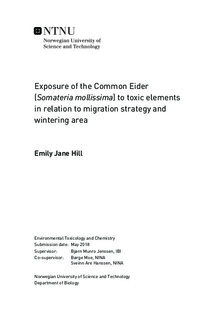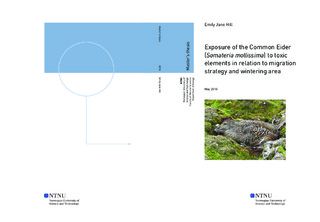| dc.description.abstract | The Common Eider (Somateria mollissima) is a long-lived sea duck with a Holarctic distribution. Eiders within breeding populations have a predictable migration strategy, shown by capture-recapture research using geolocation devices. Within the Arctic, the Svalbard breeding population of eiders are migratory, flying south to Norway and Iceland during the winter. Other populations such as those breeding in Iceland and Norway are sedentary, remaining in the wintering area year-round. This difference in migration strategy likely affects exposure to toxic elements due to difference in diet, geography and anthropogenic emissions.
During the breeding period of 2010, 2011, 2012 and 2017, eggs were collected from breeding female eiders in Svalbard, Northern Norway and North East Iceland. Eggs were analysed for a suite of elements including toxic elements mercury (Hg), arsenic (As), lead (Pb) and selenium (Se). By analysing eggs from both the breeding and wintering area of Svalbard eiders, we aimed to elucidate the relative contributions of breeding and wintering area to exposure of eiders to toxic elements. Additionally, by analysing eggs from migratory and sedentary eiders, we aimed to determine whether migration strategy plays a role in exposure of eiders to toxic elements.
Breeding area rather than wintering area had a significant effect on toxic elements. Eiders breeding on Svalbard had similar levels of toxic elements regardless of wintering area, indicating extensive feeding in the breeding area prior to egg-laying. This has implications for what is known about resource allocation strategy in eiders and warrants further investigation. Migratory eiders had a large variability in levels of toxic elements, likely explained by the variability in arrival date to the breeding ground. Additionally, eiders breeding on Svalbard had elevated Pb compared to sedentary eiders, likely explained by geologic enrichment on Svalbard. Sedentary eiders breeding in Norway had elevated As and Se, possibly reflecting a more marine diet due to the proximity of this population to the open ocean. There was no difference in Hg between breeding groups. All toxic element concentrations were below levels associated with toxic effects in wild birds.
These findings have implications for management of migratory and sedentary populations, as difference in migration strategy appears to expose eiders, and potentially other seabirds to varying levels of toxic elements such as Hg, Pb and As. | |

